Analysis of Safety Compliance and Accident Impacts on Lost time Performance of Small Scale Automotive Maintenance Workshops in Calabar
Oliver*
Department of Mechanical Engineering, Michael Okpara University of Agriculture, Nigeria
Submission: April 04, 2018; Published: June 07, 2018
*Corresponding author: Oliver, Department of Mechanical Engineering, Michael Okpara University of Agriculture, Nigeria, Email: theinah88@gmail.com
How to cite this article: Oliver. Analysis of Safety Compliance and Accident Impacts on Lost time Performance of Small Scale Automotive Maintenance Workshops in Calabar. Eng Technol Open Acc. 2018; 2(1): 555576. 10.19080/ETOAJ.2018.02.555576
Abstract
The objective of the present research is twofold; first to assess the level of safety compliance practices among artisans and secondly, to measure the impacts of unplanned lost time emanating from accident on time performance of small-scale auto maintenance firms. Ninety different auto-maintenance jobs executed by Automobile, Heavy duty, Generator and Panel beater auto firms between, January to December, 2016 were sampled using direct observation. Furthermore, primary data collected were analyzed using MS Excel 2013 and Minitab 17 software. Results revealed the mean performance rating of workshops on the availability and usage of personal protective equipment as 143.9 and 154.7. While 224.2 and 302.7 constitutes respective poor usage rate and non-availability of (PPE) in the respective workshops. Results further revealed 58.2% as average productive lost time rate resulting from accident occurrence. Conversely, regression analysis revealed that a unit increase of 659.2, 63.5 and 82.8 in accident, severity and lost time index, caused a decreased of -150.8 in overall productivity lost factor. With a coefficient of determination (R2) of 72.01% at p-value less than 0.005. Hence, a positive and significant relationship between accident and auto mechanics time performance exist. Therefore, sensitization of stakeholders in this sector on the usage of PPE and the need to make safety their priority as well as regular inspection for safety compliance by regulatory bodies are recommended to build customers trust and improve productivity in this sector.
Keywords: Automotive maintenance; Safety measures; Small scale; Accident index; Severity index; Lost time index; Overall productivity lost factor
Nomenclature
Aindex Accident index
Atime Actual time
No Number of observation (90)
Ptime Planned time
Sindex Severity index
Tindex Time index
ai Constant expressing weighting given to each factor, at i=1,…4
β0 Constant estimated by regression model
β1,β2,β3 Coefficients of explanatory variable
b Frequency of the occurrence
OPLF Overall Productivity Lost factor
PLTR Productive lost time rate
N Total number of occurrence
i Recordable accident within the period
w Number of workers performing maintenance
Introduction
Dhillon et al. [1], described maintenance as appropriate actions made for retaining an item/part/equipment, or restoring it to a given condition. Concisely, maintenance is undertaken to restore broken equipment’s, preserve equipment conditions and prevent their failure, which ultimately reduces production loss and downtime as well as the associated safety hazards. In Nigeria, large proportion of auto maintenance firms are classified as “small scale”. This classification owe to the fact that the sector is characterized by low capital output ratio, that is the ratio of capital level relative to output is low, [2]. SMS automotive maintenance firms are vital to human resources in the automobile industry in virtually every nation’s economy due to its significant contribution in terms of job creation. Kayemuddin & Kayumm [3], described the automotive maintenance workshop as a category of small scale industry that contributes about 8.8% to the GDP of a nation’s economy. In Nigeria, the industry records about 3billion as turnover annually to the local economy according to the regulatory body of mechanics in Nigeria, National Automobile Technicians Association (NATA) in its report “Nigeria economy and the mechanic” of October 12, 2012. Auto mechanics are involved in the repairs and maintenance of automotive facilities such as vehicles and generating plants to enhanced optimum performance when they breakdown [4]. Other task includes replacement of worn mechanical parts that can cease transmission or prove unsafe for effective operation, [5]. SMS auto maintenance firms are characterized by preventive and corrective maintenance. Preventive maintenance is defined as a series of pre-planned tasks performed on auto facility either according to manufacturer’s schedule to counteract the known causes of potential failures of the intended functions of an asset [6]. Preventive maintenance (PM) plays a vital role to mitigate if possible avoids potential stoppages and disruptions of equipment or machinery from occurring in daily operations. While corrective or breakdown maintenance, is performed when a system or machine fails. It includes repair and replacement of failed parts to create an optimal performance again. Corrective maintenance activities are, in contrast to preventive maintenance, not schedulable [7]. This makes them harder to plan and more costly to perform. However, hardly are these activities or maintenance by auto mechanics completed without hazards, thereby stimulates negative effects such as time delay, increased costs, and productivity loss. The imbalance relative to safety compliance among auto mechanics during maintenance has significantly impacted performance time and is a major concern [8,9]. Industrial safety, health and environmental management opined that in order to meet the different needs which are seen in the present day industrial environment which demands increased production, high efficiency, and cost control etc. The subject of safety, health and environment must come into play, otherwise any neglect in these aspect can prove very costly. Neglect of safety at any stage can result into disasters leading to loss of human life and production. Thus, it is imperative to evaluate the level of accident/ injuries and safety compliance in small scale auto maintenance firms and its impact on time performance.
An accident is defined as any unplanned event that result in the combination of the following consequences; physical injury, lost time case, loss of property and number of fatalities [10]. While safety measures are facilities and strategies that are put in a workplace place to prevent or reduce accident during various stages of project [11]. Accordingly, Oisamoje, and Enaruna [12] defined health and safety management as an area that is concerned with ensuring the safety, health and welfare of people engaged in work or employment. Consequently, there are several risks which expose auto mechanics to workplace accidents/ injuries in the automotive maintenance workshops. Some of these risks include exposure to chemicals, strenuous work postures, and the use of improperly specified tools and lack of safety compliance [13-15], thus, affecting their performance. However, to efficiently regulate an issue, one should satisfactorily define the problem. Bozena [16], opined that the level of accident in a particular sector like the construction industry is estimated by the labour force in the analyzed sector, the number of victims of accidents at work and the number of days lost resulting from accident at work. The Statistical Office of the European Communities (Eurostat), established specific indicators that enables any company to report their number of accident and accident index (defined as the number of accidents per 100,000 working persons). Also, the Office of Environmental Health and Safety, established specific models that enable any firm to report their recordable incident rates, lost time rates, and severity rates, so that they can be compared with other industry or group. According to OEHS, the standard base rate for the calculations is based on a rate of 200,000 labour hours. This number (200,000) equates to 100 employees, who work 40 hours per week, and who work 50 weeks per year. Using this standardized base rate, any company can calculate their rate(s) and get a percentage per 100 employees. However, one of the limitations about this approach is that none of the above indicators provides any evidence about the achieved values of productivity indices. It is therefore proposed in the current study to take productivity indices, e.g. delivery efficiency into account in accident level assessments of automotive maintenance firms. This is because unplanned idle time resulting from industrial accidents reduces real time productivity and increases delay. Downtime or lost time refers to the variation between the estimated finish and the actual finish time of tasks either resulting from ill health or injuries/accident. Lost time is an imperative issue in industries because of its relation to productivity and business profitability [17]. Evaluating the causes and impacts of accident/injuries on productivity performance in automotive maintenance workshops, has become a necessity. Because productivity rises as the number of incident related cases reduces, and the use of properly designed tools increases [18]. Hence, small scale automotive maintenance firms needs to be aware that lost time resulting from the use of improperly designed tools and lack of safety compliance as well as accident/injuries cases, whether planned or unplanned, is very costly.
Methodology
Primary data used in the current study were basically obtained through survey design approach with direct observation of two automotive maintenance workshops each sampled across forty-five different small scale auto firms, amounting to ninety observations. This comprises of heavy duty, automobile, generator and panel body auto firms caught across the seven layouts (Eight- Mile, Diamond Hill, Anantigha, Essien Town, Ikot Enobong, Big- Qua Town and Etta-Agbor) in Calabar metropolis where SMS auto firms are found in their large numbers. Each auto firms had a work force of at least four to six artisans performing different repairs at a duration of 8hours daily (i.e. the peak hours of industrial activities), for 6days per week, excluding Sundays, for a period of twelve months between January to December 2016. The data collected was tabulated and classified according to maintenance characteristic (i.e. initial and actual final time, actual performance, number of incident/injuries that resulted to lost days overrun cost and time, and the severity rate of incident). This was done to ensure that all variables considered were clearly defined. Furthermore, Microsoft Excel 2013 and Minitab 17 statistical tools were used for analyses of the data. Additionally, the analysis on proper usage and safe handling of tools were ranked by the measurement of the relative index ranging from (1= Excellent, 2= Very Good, 3= Poor, 4= none). Where 1 to 3 implies the level of usage or availability of tools impact, to ascertain the mean rating of each response on safety compliance in SMS auto maintenance firms.

Eqns. (2), (3), (4) and (5) defines the magnitude of lost time index, time index, time performance achieved and productive lost time rate of each project at completion [19-23].
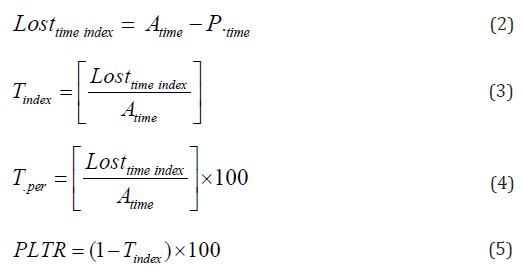
Also, Eqn. (6) defines the Overall Productivity lost factor (OPLF) of each auto firm’s project executed.

OPLF helps to break down the reasons for productivity losses into three main factors, which include; accident index, lost time index and severity. Ideally, one fundamental area that every organization can improve upon is productive efficiency/ conformity and one of the best measures is OPLF. A possible explanation to this argument is that organizational efficiency has relevance for business profitability.
Accident index and severity for each sector was determined as expressed in Eqs. (7) and (8).

Accident index measures the productive time losses resulting from accident from a predetermined sample. And is calculated by dividing the number of incident/injuries in each sector by the total number of observation [12].

The severity index quantifies the average number of working days lost due to a worker’s involvement in minor and serious accidents [16]. Furthermore, multiple linear regression analysis in MS Excel and Minitab 7.1 statistical tools were used to establish the relation between overall productivity lost factor (OPLF) from accident index, lost time and severity index, and graphs plotted accordingly. The element of multiple regressions is expressed in equation (9).

Results and Discussion
Figure 1 present the result of common injuries/accident identified to be associated with the four selected auto firms (automobile, heavy duty, generator and panel beater workshop) which vary from superficial wounds, dislocation, burns, bruises, cuts, and backache, as evaluated using eqn (6) (Figure 1).
It is obvious from Figure 1, that superficial wounds, burns injuries, and was prevailing among panel body work auto mechanics with an average of 28.1% and 18.7%. Similarly, dislocation injuries/accident was common among heavy duty firms with an average of 44.4% been the highest. This group of auto technicians have to constantly lift heavy items which can strain their back, adopt awkward postures and may spend long hours bent over or lying on their back. Furthermore, cuts and bruises incident cases was found to be common with generator firms. A possible explanation to this finding is that most of this firms lack the basics personal protective equipment, and as such they fail to use them. For instance, auto mechanics in panel beater auto firms reported being aware of the hazards associated with their jobs when interviewed, but stated that awareness did not seem to help reduce the health problems they suffered. Additionally, the analysis on proper usage and safe handling of tools, as depicted in Figure 2 shows that about 55.1% of automotive maintenance firms, lack the ability to handle hand tools before and after each maintenance.

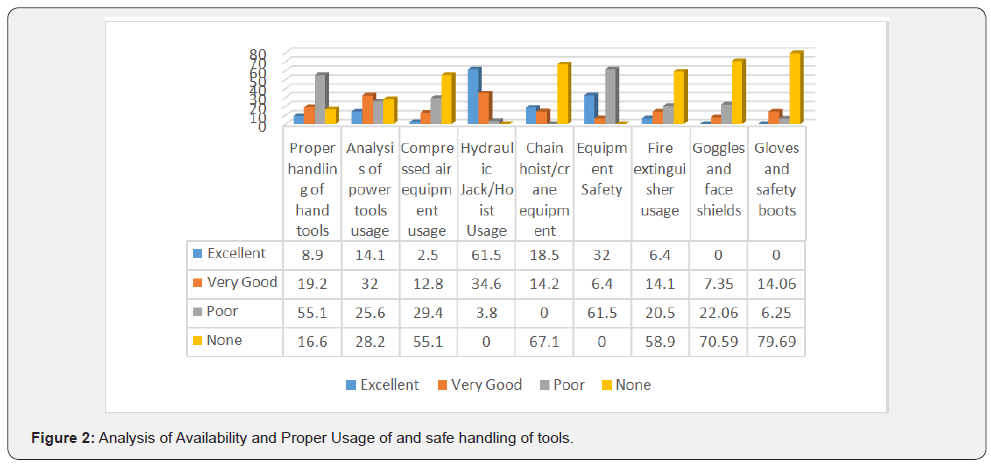
While about 19.2% averagely practiced safe handling of hand tools. Also an average of about 16.6% of these workshops do not even consider the handling of tools as a safety measure to be observed. Also, the proper usage of power tools was marginal with an average of 32.0%. While 28.2% didn’t make any attempt within the period under consideration. The proper usage of compressed air equipment was found to be 2.5% on the average, while 12.8% observed the safety rules of wearing safety glasses or face shield during operation to avoid metal particles into the eye. Also about 29.4% used this equipment poorly by not observing the safety rules, with unavailability of 55.1%. Also, from the result as depicted the proper usage of hydraulic/hoist equipment by auto mechanics was at an average 61.5% and 34.6 marginally applied the safety rules while using it, and 3.8% used it but never considered safety precaution at all level. Furthermore, Figure 2 reveals that only 18.5% auto mechanics appropriately used chain hoist and crane when lifting an automobile engine from the sitting. While 14.2% marginally used it well and unavailability of 67.1% on the average. This is basically found among un standardized workshops, as they lift engine manually using their hands. It was obvious from that safety practice towards equipment maintenance was lacking in most of the repair firms as majority of these mechanics fail to ensure effective cleaning of equipment/ tools before and after use. The unavailability of fire extinguisher among the auto repair firms was on the high side with an average value of 58.9%, while about 20.5% had it in their workshop, but weren’t in good condition. Except for few workshop which had it in good operational condition with an average of 6.4% and 14.1% respectively. According to survey the unavailability of goggles and face shield among auto technicians, especially panel bitters was on the high side with an average value of 70.59%, while about 22.06% had it in their workshop, but was in poor condition. From analysis the unavailability of hand gloves and safety boot among the auto firms was high with an average of 79.69% (approximately 80%).This implies that most local mechanics violate the rule of wearing safety personal protective (e.g. gloves and safety boot) equipment when working. This is because most of the local mechanics were of the opinion that protective equipment must be provided by their masters or owners of the workshops.
Also, descriptive analyses of the ninety maintenance projects of the four sectors (heavy duty, automobile, generator, and panel beater auto firms) evaluated reveals the following findings in studying time performance and lost work days, as presented in Figure 3-6 respectively.
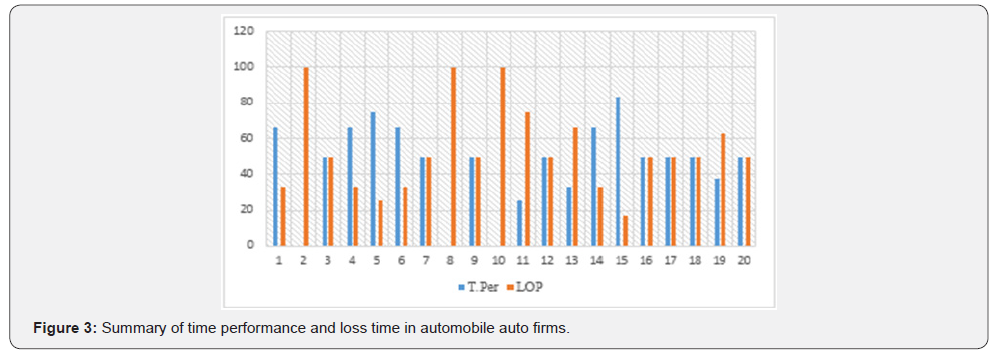
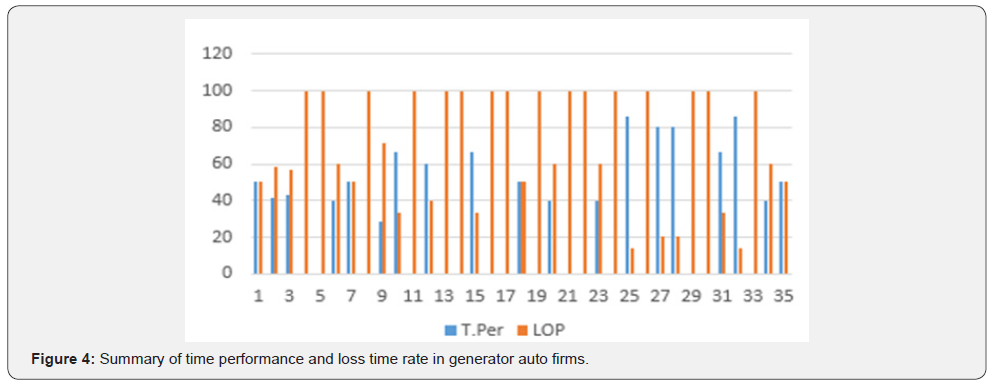
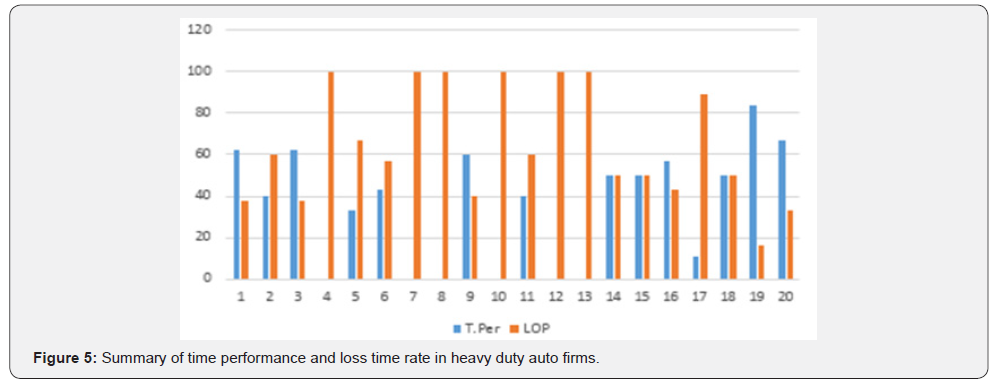

It is clearly seen from the Figures 3-6 the need to maintain close link between time performance and lost time resulting from injuries/accident related cases. Obviously, as time performance (efficiency) reduces, lost time increases. This implies that the relationship between time performance and productivity is inversely proportional i.e. the higher the time efficiency rate, the lower the productive time losses and equally, the lower the time efficiency rates, the higher losses in productivity. Also, Table 1, further present the summary of comparative analyses of time performance and lost time rate inherent in each auto firms.

However, to determine the overall productivity lost factor (OPLF) of each auto firms, the index of accident, lost time index and severity index values were computed as depicted in Table 2. Within these auto maintenance sectors, the accident index range between 0.133, 0.111, 0.155, and 0.277 for automobile, generator, heavy duty and panel beater auto firm. This implies that panel beater autos firms recorded the highest number of injuries with an accident index of 0.277. Thus, recording lost time index of 62 and 2.48 as severity index and 42.69% as overall productivity lost factor. This is repeated for automobile, generator, and heavy duty auto firms respectively as presented in Table 2.

However, an explanation to these findings is that artisans in panel beater auto maintenance firms constantly get in contact with hot surfaces, exhaust pipes, radiator and cooling system pipes, soldering and welding operations due to the nature of maintenance practices.
Furthermore, Table 3 shows the result of the multiple liner regression model formulated to relate overall productivity lost factor with accident index, lost time and severity index as presented in eqn. (9). Table 3 indicates that the accident index has a beta coefficient ( β0) of 659.2 at a probability value of 0.000 < 0.05. Hence, it is significant. This indicates that OPLF decrease by -150.8 when accident index increases by 659.2 when all other independent variable is held constant. For every unit rise in accident index, there was a unit decrease in overall productivity lost factor.
R2 = 72.01%, R2 (adj) = 71.03%, F −Value = 73.75, P −Value = 0.000

It can then be inferred that accident index has an impacts on overall productivity lost factor. The data further revealed that severity index has a coefficient of 63.5 at a probability value of 0.036 less than 0.05. Hence, it is significant, this indicates that, for each unit increase in severity index, there is a corresponding decrease of -150.8 in overall productivity lost factor when all other independent variables are held constant. Similarly, the data further reveals that lost time has a coefficient of 82.8 at p-value 0.000<0.05. This equally indicates that an increase of 82.8 in lost time caused a reduction of -150.8 in overall productivity lost factor when all other independent variables are held constant. Coefficient of determination (R2)=72.01%. This indicates that all variations in the dependent variables are as a result of the independent variables. That is, 100% variation in overall productivity factor is as a result of changes in accident index, severity index and lost time.
Conclusion
The impacts of unplanned lost time emanating from accident/injuries on time performance of small-scale automotive maintenance firms has been evaluated using descriptive analysis and multiple linear regression technique. Descriptive analysis of ninety auto maintenance jobs executed across Automobile, Heavy duty, generator and panel beater auto firms between January to December, 2016 revealed the mean performance rating of workshops on the availability and usage of appropriate protective equipment were determined as 143.9 and 154.7 respectively while 224.2 and 302.7 constitutes respective poor usage rate and non-availability of appropriate safety equipment in the workshops. Results further revealed an average productive lost time of 58.2% resulting from accident/injuries. Conversely, regression model formulated revealed that a unit increase of 659.2, 63.5 and 82.8 in accident, severity and lost time index, caused a decreased of -150.8 in overall productivity lost factor. With a coefficient of determination (R2) of 72.01% at probability value less than 0.005. Hence, it is concluded that compliance to appropriate safety practice in this sector is very poor due to nonchalant attitude of the operators of these firms toward safety practices as well as inadequate diagnoses tools and supervision by regulatory agencies. This study could also be extended to other local artisans in the small scale industries such as auto electric technicians etc. in Nigeria to possibly identify the risks associated with non-safety compliance and the impacts of occupational accident on productivity performance. Therefore, sensitization of stakeholders in this sector on the need to make safety their priority and regular inspection of these firms for safety compliance by regulatory bodies are recommended to build customers trust and improve productivity in this sector.
References
- Dhillon BS (2002) Engineering Maintenance, A Modern Approach, CRC Press, Boca Raton, USA.
- Ijaiya GT, Umar CA (2004) the Informal and Formal sector Interlinkages and the incidence of poverty in Nigeria: A case study of Ilorin metropolis. African development 29(3): 84-102.
- Kayemuddin Md, Kayum S (2013) Problems and prospects of automobile workshops in Bangladesh. Journal of African Studies and Development 5(6): 157-162.
- Akinola AO (1995) Parts standardization in motor industry. B. Eng. Thesis, Dept. of Mechanical Engineering Federal University of Technology, Akure, Nigeria.
- Vyas H, Das S, Mehta S (2011) Occupational Injuries in Automobile Repair Workers. Industrial Health 49(5): 642–651.
- Ben‐Daya M, Duffuaa SO (1995) Maintenance and Quality: the missing link. Journal of Quality in Maintenance (MCB University Press) 1(1): 20‐26.
- Wallace RB, Prabhakar Murthy DN (2003) Case Studies in Reliability and Maintenance. New Jersey: John Wiley and Sons, USA.
- Christian MS, Bradley JC, Wallace JC, Burke MJ (2009) Workplace safety: A meta-analysis of the roles of person and situation factors. Journal of Applied Psychology, 94(5): 1103-1127.
- Hassam SF, Mahamad KAK (2012) A study of occupational safety hazards: Safety and health issues in automotive industry. In Statistics in Science, Business, and Engineering (ICSSBE), International Conference on (pp. 1-6), Langkawi, Malaysia.
- Aniekwu N (2007) Accidents and safety violations in the Nigerian Construction Industry. Journal of Science and Technology (Ghana) 27(1): 81-89.
- Okeola OG (2009) Occupational Health and Safety (OHS) Assessment in the Construction Industry. 1st Annual Civil Engineering Conferencez
- Oisamoje MD, Enaruna EI (2013) An Exploration of Health and Safety Management Issues in Nigeria’s Effort to Industrialize. European Scientific Journal 9(12): 1857-7881.
- Hunt JP, Cathy CT, Michael PD, Anthony M (2000) Occupation-related burn injuries. J. Burn Care Rehabil 21(4): 327–332.
- Rongo L, Barten F, Msamanga G, Heederik D, Dolmans W (2004) Occupational exposure and health problems in small-scale industry workers in Dar es Salaam, Tanzania: a situation analysis. Occup Med 54(1): 42–6.
- ILO (2000) International Labour Organization. International Data Sheet on Occupation, Automobile Mechanics. ILO, Geneva.
- Bozena H (2007) General model of accident rate growth in the construction industry, Journal of Civil Engineering and Management 13(4): 255-264.
- Nwanya SCCN, Achebe OO, Ajayi CN, Mgbemene (2016) Process Variability Analysis in Make-to-Order Production Systems. Cogent Engineering, 3: 1269382.
- Riggs JL (1987) Production Systems: planning, Analysis, and Control, fourth Edition, John Wiley & Sons, USA.
- Rezaei AR, Çelik T, Baalousha Y (2011) Performance measurement in a quality management system. Scientia Iranica 18 (3): 742–752.
- Leonard CA (1988) The Effects of Change Orders on Productivity, M.S. Thesis, Concordia University; Montreal, Quebec. Cost Engineering 50(12).
- Hoehn W (2003) Managing organizational performance: linking the balanced scorecard to a process improvement technique, Proc. 4th Ann. Int. Symp. Ind. Eng. Per. Manag. Kasetsart University, Thailand, pp. 1–12.
- Neely A, Mills J, Platts K, Richards H, Gregory M, et al. (2000) Performance measurement system design: developing and testing a process-based approach, International Journal of Operations and Production Management 20(10): 1119–1145.
- Ibrahim M (2012) Effects of project’s physical characteristics on cost deviation in road construction. Journal of King Saud University- Engineering Sciences 25(1): 81–88.






























